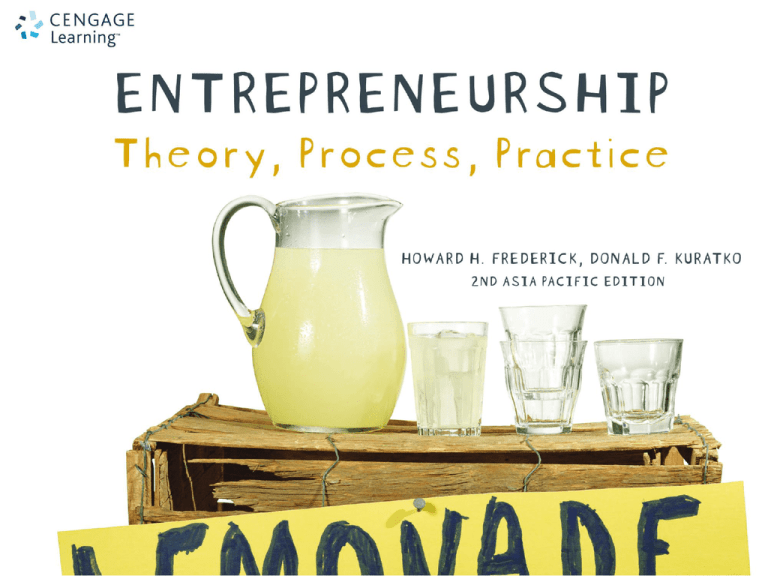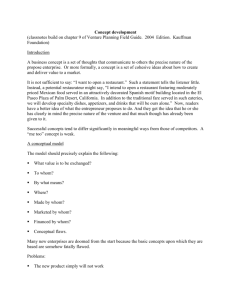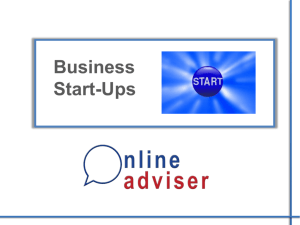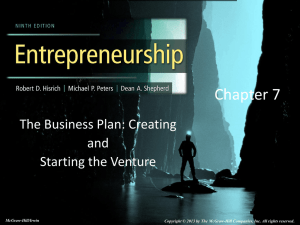Business angels
advertisement

Chapter 12 Developing a sustainable business plan PowerPoint permissions Cengage Learning Australia hereby permits the usage and posting of our copyright controlled PowerPoint slide content for all courses wherein the associated text has been adopted. PowerPoint slides may be placed on course management systems that operate under a controlled environment (accessed restricted to enrolled students, instructors and content administrators). Cengage Learning Australia does not require a copyright clearance form for the usage of PowerPoint slides as outlined above. Copyright © 2010 Cengage Learning AustraliaPty Limited Objectives 1. 2. 3. 4. 5. 6. 7. To define a sustainable business plan and demonstrate its value To explore the business planning pitfalls that plague many new ventures To describe the benefits of a business plan To set forth the viewpoints of those who read a business plan To emphasise the importance of coordinating the business plan segments To review key recommendations by venture capital experts regarding a business plan To present a complete outline of an effective business plan 8. To present some helpful hints for writing an effective business plan 9. To highlight points to remember in the presentation of a business plan 10. To underline some of the contrarian viewpoints on the importance of a business plan. 3 But first ? Q. What is a ‘business plan’? Q. And what could it be used for? 4 What is a business plan? • A document in which you: – – – – Make your business case Describe your operations Identify your management team Project the future financial situation • A tool for determining the essential operations • A primary document for managing the venture and raising funds • The entrepreneur’s roadmap 5 What about sustainability • Consider ‘impact’, in terms of: – Greenhouse gases – Energy use – Product life-cycle • Industrial systems (including firms) are not separate from the biosphere 6 The sustainable business plan 7 Business plan pitfalls 1. 2. 3. 4. Green theming No realistic goals Failure to anticipate roadblocks No commitment or dedication 5. Lack of demonstrated experience 6. No market niche 8 Benefits of a business plan • For the entrepreneur – Analyses all aspects of the venture – Strategy for uncertainties – Critical and objective view – Scrutinises assumptions – Examines operating strategies and expected results – Measurable benchmarks –A communication tool for sources of funding – A tool for guiding the venture • For the investor – – – – – Details of market potential and securing market share Ability to service debt and provide adequate returns Critical risks and crucial events A comprehensive overview of the entire operation A useful guide for assessing planning and managerial ability 9 Who reads the plan? ? Q. Who might be interested in reading your plan? (Identify all of the potential audiences) 10 Who reads the plan? • • • • • • Venture capitalists Bankers Investors Potential large customers Lawyers Consultants • Suppliers 11 Who reads the plan? • Bankers Stress financial aspects of the proposal • Equity investors and venture capital fund managers Emphasise market and finance issues • Business angels Look at the entrepreneur and ‘investor fit’ 12 Three viewpoints 1. The entrepreneur’s viewpoint 2. The potential customers’ viewpoint 3. The investors’ viewpoint 13 The five minute reading • The venture capitalists’ approach: 1. What are the characteristics of the venture and its industry? 2. What is the financial structure of the plan? 3. What does the balance sheet say about liquidity, net worth and debt/equity? 4. What is the quality of the entrepreneur(s)? 5. What is the unique feature of this venture? 6. Then, they skim read the entire plan 14 Putting the package together • Appearance – middle ground (plastic spiral bound, mostly single colour) • Length – no more than 50 pages • Cover and title page – company name, address and issue date • The executive summary – two to three pages • Table of contents 15 Ten guidelines 1. 2. 3. 4. 5. 6. 7. Keep the plan respectably short Organise and package the plan appropriately Orient the plan towards the future Avoid exaggeration Highlight critical risks Give evidence of an effective entrepreneurial team Do not over-diversify 8. Identify the target market … and be able to 9. Write in the third person confidently answer the ten 10. Capture the reader’s interest questions under the heading ‘Questions to be answered’ 16 Business plan outline ? Q. What content might you expect to see included in a business plan? 17 Business plan outline 18 Business plan outline (cont.) 19 Business plan outline (cont.) Adapted from: Donald F. Kuratko and Robert C. McDonald, The Entrepreneurial Planning Guide, Bloomington: Kelley School of Business, Indiana University, 2007 20 Business plan elements (1) I. Executive summary – – II. Write this after the rest of the business plan A clever snapshot of the complete plan Business description – – III. Industry background, status and future trends Thoroughly describe the venture Sustainability – Define sustainability relevant to the business 21 Business plan elements (2) IV. Marketing – V. (As per Chapter 10) Operations – VI. Location, labour availability, wage rate, proximity to suppliers, customers and community support, taxes and zoning, plant and equipment Sustainable development measures of performance – Describe how sustainability can be demonstrated (including triple bottom line indicators) 22 Business plan elements (3) VII. Management – Key personnel, advisers, consultants, or members of the board; structure of payment and ownership VIII. Financial – – IX. (As per Chapter 11) Viability of the undertaking, pro forma balance sheet, income statement and cash–flow statement Critical risks – Unfavourable trends and difficulties 23 Business plan elements (4) IX. Harvest strategy – X. Management succession and investor exit strategies Milestone schedule – XI. Provide a timetable for the various activities Appendix and/or bibliography – Additional documentation 24 A practical example Refer to Appendix 1 for an example business plan – ‘Red River Optical: Affordable reading glasses for Vietnam’ 25 The pitch ? Q. Now it is written. How can you (verbally) present your plan to an audience? 26 The pitch • Presenting the plan to stakeholders – especially funding providers • This is also known as ‘the elevator pitch’ • Be organised, well-prepared, interesting and flexible 27 The pitch • • • • • Focus on the plan Demonstrate a reachable market Explain the business model Tout the management team Explain the metrics • Motivate the audience • Answer: ‘Why you?’ and ‘why now?’ 28 Key concepts ? (close your books) Q. Who will read your business plan? Q. What are the main sections in a business plan? 29 Key concepts • Business plan audiences – Venture capitalists, bankers, investors, potential large customers, lawyers, consultants and suppliers • The business plan outline: I. II. III. Executive summary Business description Sustainability IV. Marketing V. Operations VI. Sustainable development measures of performance VII. VIII. IX. X. XI. XII. Management Financial Critical risks Harvest strategy Milestone schedule Appendix and/or bibliography 30





![Chapter 3 – Idea Generation [ENK]](http://s3.studylib.net/store/data/007787902_2-04482caa07789f8c953d1e8806ef5b0b-300x300.png)

